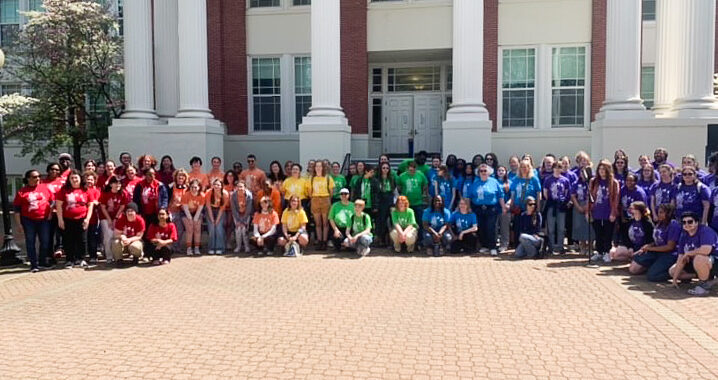BOV discusses master plan, police
6 min readThe Board of Visitors (BOV) met last week for a lengthy meeting to discuss the many changes and issues at the university, which included the details of the master plan and preservation plan, relations with Fredericksburg and Campus Police and tuition changes.
At the meeting on Saturday, Feb. 16 an update of the master plan and preservation plan was explained in the meeting.
Rick Pearce, vice president for administration and finance introduced the topic with a copy of the first draft of the final Master Plan in hand.
This draft is similar to the original draft, except that there is now a preservation plan in place to “grade” each building on campus.
The preservation plan, said Pearce, “will help us decide whether or not we’re going to renovate a building, we’re going to raze a building, we’re going to preserve a building; it’s going to inform all of that.”
The preservation plan will inform how the master plan will be carried out, according to Pearce.
The preservation plan will not be finished for another 4-5 months according to Pearce, and will help finish the master plan and “put it to bed,” Pearce said.
Scott Sullivan architect from Burt Hill architectural firm outlined the future plans for the buildings on campus with a detailed slideshow.
Sullivan said that he didn’t think the plan would be doing anything “too controversial to the university,” and that it follows the preservation plan well.
The classrooms are being used very well he said, and 365 more students could be enrolled before classrooms are full.
There is “adequate parking on campus today,” he said, noting that this is probably a surprise to a lot of people since it’s a major concern.
He said the “real issue is that the center of campus is where parking is lacking,” and that there needs to be a “change in perception” about how close parking is to buildings.
A new parking deck is proposed on College Avenue, located near the smoke stacks across from DuPont Hall.
The location of the public safety office, right now stationed in Brent Hall, will also be moved near this parking deck to ensure better safety for students.
Some of the major topics Sullivan talked about were the new campus center, a new parking deck and an extension to Campus Walk.
Jepson is “the most stressed” academic building on campus, he said, as the science labs are the most frequently used.
A 20 thousand square-foot addition to Jepson to increase the amount of labs is proposed, which Sullivan said will complement the building and not overwhelm it.
The suggestion is to make Mercer Hall the future home for the department of psychology and the second floor of Woodard the future home for the College of Business, since they are in “dire need of renovation,” according to Sullivan.
The “residence halls are beautiful buildings,” Sullivan said, but they are in “need for renovation.”
Virginia, Willard, Ball, Custis, and Madison Halls are going to need renovations within the next ten years, according to the plan.
Bushnell Hall will be demolished, as renovation would not yield as many rooms for students.
It is a “prominent location,” and can be replaced with a slightly larger building, Sullivan said.
It will be used as a living and learning facility, with classrooms on the first floor and dorms on the second.
Marshall Hall is also planned to be demolished.
The problem with Framar and South Halls is that some are in “very poor condition,” are not ADA compliant with the Americans with Disabilities Act (ADA), and would not benefit the university financially to renovate.
The master plan recommended that Framar and South be demolished, but the preservation plan suggests the retention of Framar.
It’s important to keep the residence halls open, according to Pearce, so some of the residence halls that only need small renovations will be completed first over the summer.
Sullivan said Pollard and Melchers Halls are in “dire need” of renovation.
One idea is to locate a new performing arts facility on the corner of Sunken Road and William Street, which would strengthen that corner of campus and possibly create collaboration with downtown Fredericksburg.
The other option would be to add an addition onto Pollard and Melchers Hall for performance space.
Seacobeck Hall, once slated for demolition, is “outgrowing” its environment and is now scheduled for renovation, according to Sullivan said.
It was built when UMW was much smaller, and now the school is growing, causing students to wait in line to eat a meal, he said.
Seacobeck will remain and be renovated, and there will be decisions made about what will be in the building.
“It is a plan; it is a guide for the future development of the campus if and when resources become available for us to execute the plan,” said Rick Hurley, “But we have to start with a plan.”
He said that many parts of the Master Plan “are subject to change as a result of a multitude of factors.”
He also said “as a university with a strong historic preservation program, it is important that we find a balance between preserving historic buildings and continuing to invest in new buildings that will strengthen our university and community.”
Pearce agreed and continued, “It’s a living document,” Pearce said. “I anticipate, as things change, this plan will change with it.”
The money needed to complete renovations is based on the type of building. Ideally the state will fund academic buildings and the rest is funded with auxiliary money, which includes costs to students.
There was also mention of refurbishing the amphitheater behind Trinkle.
Also presented at the meeting were two proposed new minors in data analysis and digital studies and a new Masters program in geo-social analytics, which the BOV approved.
The masters program will be 30 credits and will require the hire of one new faculty member in the future.
The new marketing director for UMW, Malcolm Holmes, was also introduced.
Doug Searcy, vice president for student affairs, discussed the recent break-ins on campus and the credibility of the Campus Police.
“We are looking closely at how we help the Fredericksburg Police Department with any issues within the community,” said Searcy.
The number of reported parties off campus has reduced this past semester from 71 reported calls to 50, but the number of arrests has increased, a trend on which the Bullet reported in a previous issue.
Searcy said that he wants to find a balance between “excessive arrests and appropriate arrests.”
He said there could potentially be a collaboration between the Fredericksburg and Campus Police department task force on Thursday, Friday and Saturday nights to put more “leverage of control back into the university police hands.”
This will “still hold our students accountable,” said Searcy, but “our police can follow them though our judicial system,” while Fredericksburg police can only send them downtown for arrest.
He also briefly mentioned the possibility of cameras and surveillance on campus, after the issues with the break-ins.
After Searcy gave his overview for Student Affairs, the BOV discussed finance committee affairs.
There will be a three percent increase in salary next semester for faculty and staff.
Pearce said that “the state policy says that the state will pay 67 percent of the cost in education, students should pay 33 percent,” but this has changed because of the economy fluctuating, according to Pearce.
UMW, like all universities, takes into considers the number of out-of-state students enrolled.
The state policy says that “you have to charge an out-of-state student at least 100 percent of the cost of education. In most cases, most universities charge 130 or 140,” according to Pearce, “so we’re essentially using the out-of-state students to subsidize the in-state students,” said Pearce.
“What this means is that every time there is a mandate, such as salary increase or a health insurance increase, that the state wants to split that cost between what the state pays and what the University pays, and the University essentially pays using tuition fees,” Pearce explained.
Based on the faculty and staff salary increase, there will be about a 3.5 percent tuition increase, as well as a 4.5 percent increase charged for room, board and auxiliary fees.
The plan is to increase tuition beginning now to avoid creating higher increases in the future years.
Hurley commented on student concerns over tuition increases.
“For students, one of the most salient issues that we discussed was some of the factors that impact tuition,” Hurley said.
He said we receive “a significant amount of support from the Commonwealth of Virginia,” and at the meeting the BOV was able to examine the factors that influence tuition increase.
He reassured that after the state budget is finalized, they will discuss the issue at the BOV meeting in April.












